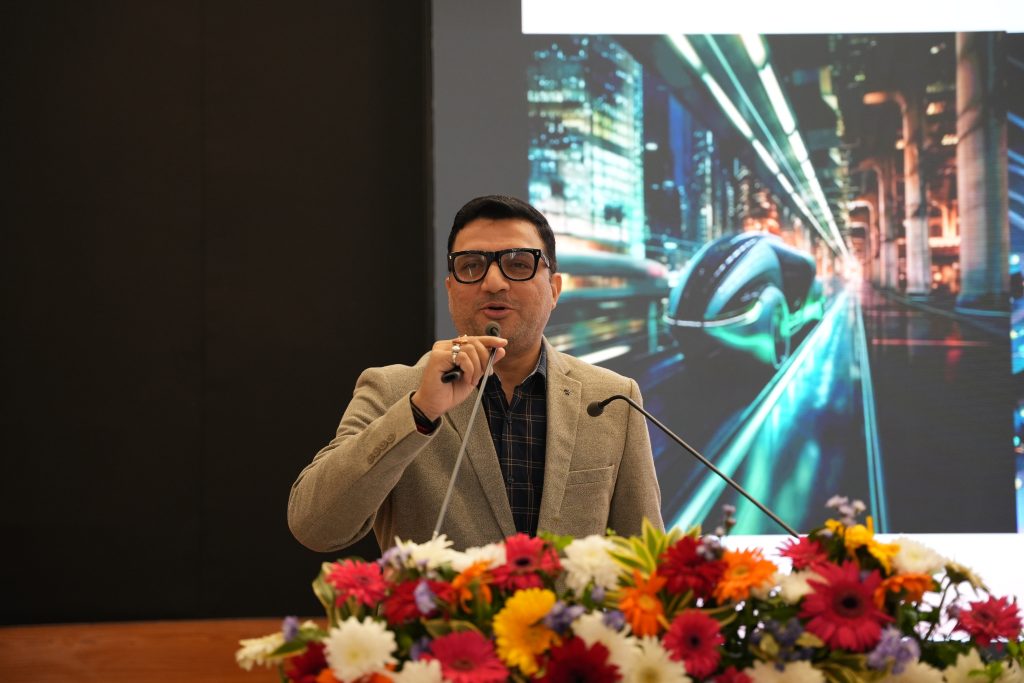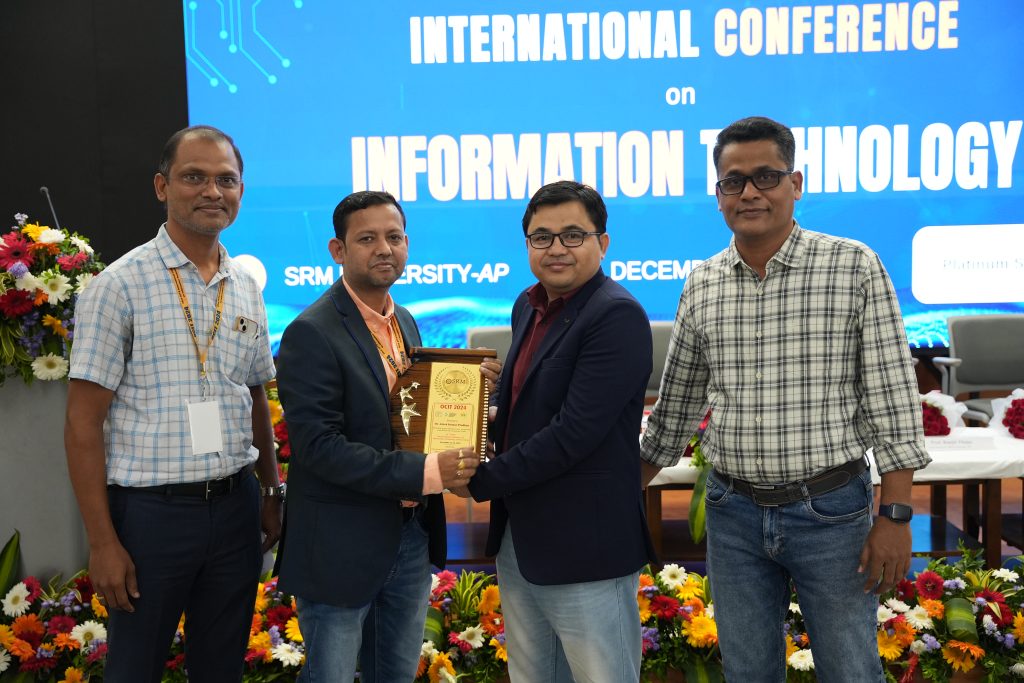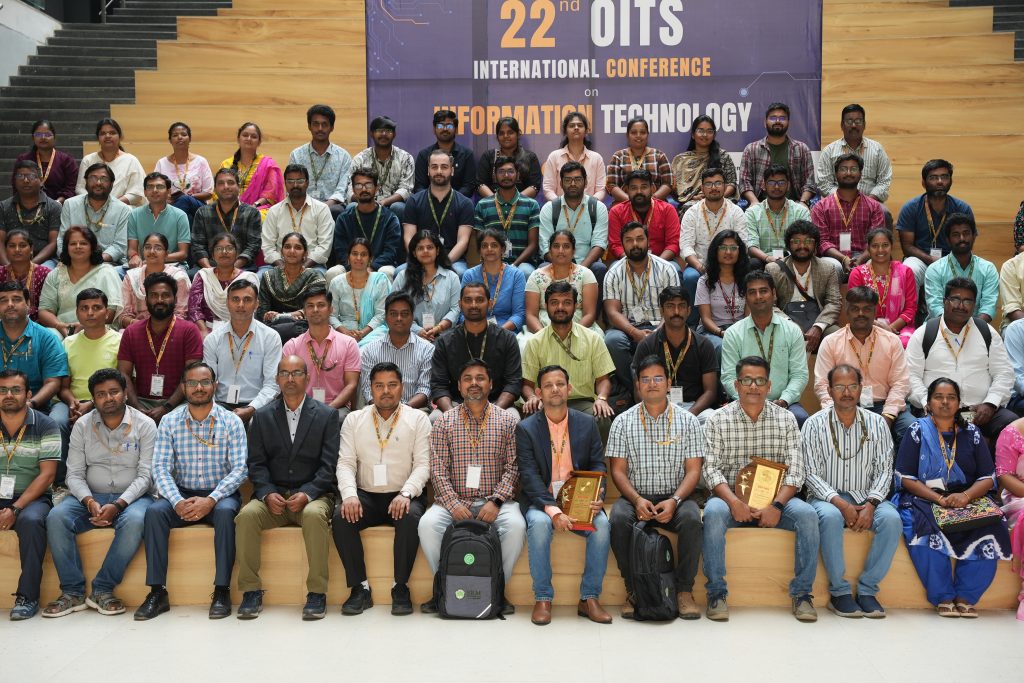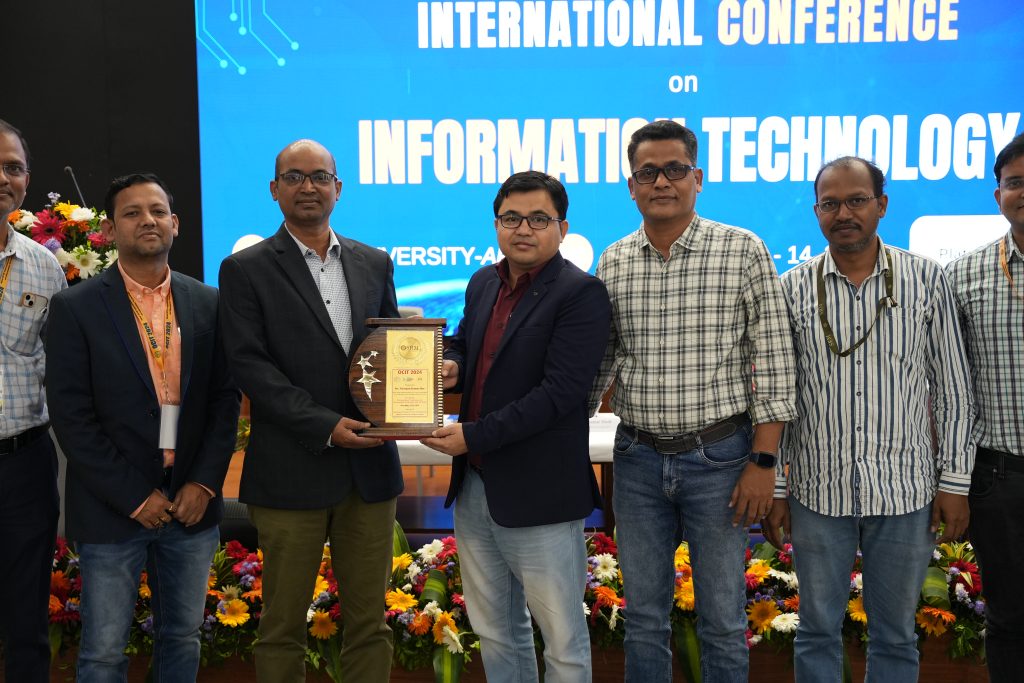Research News
- 2D Metallene Designs to Advance Multifunctional Electrocatalysis January 6, 2025
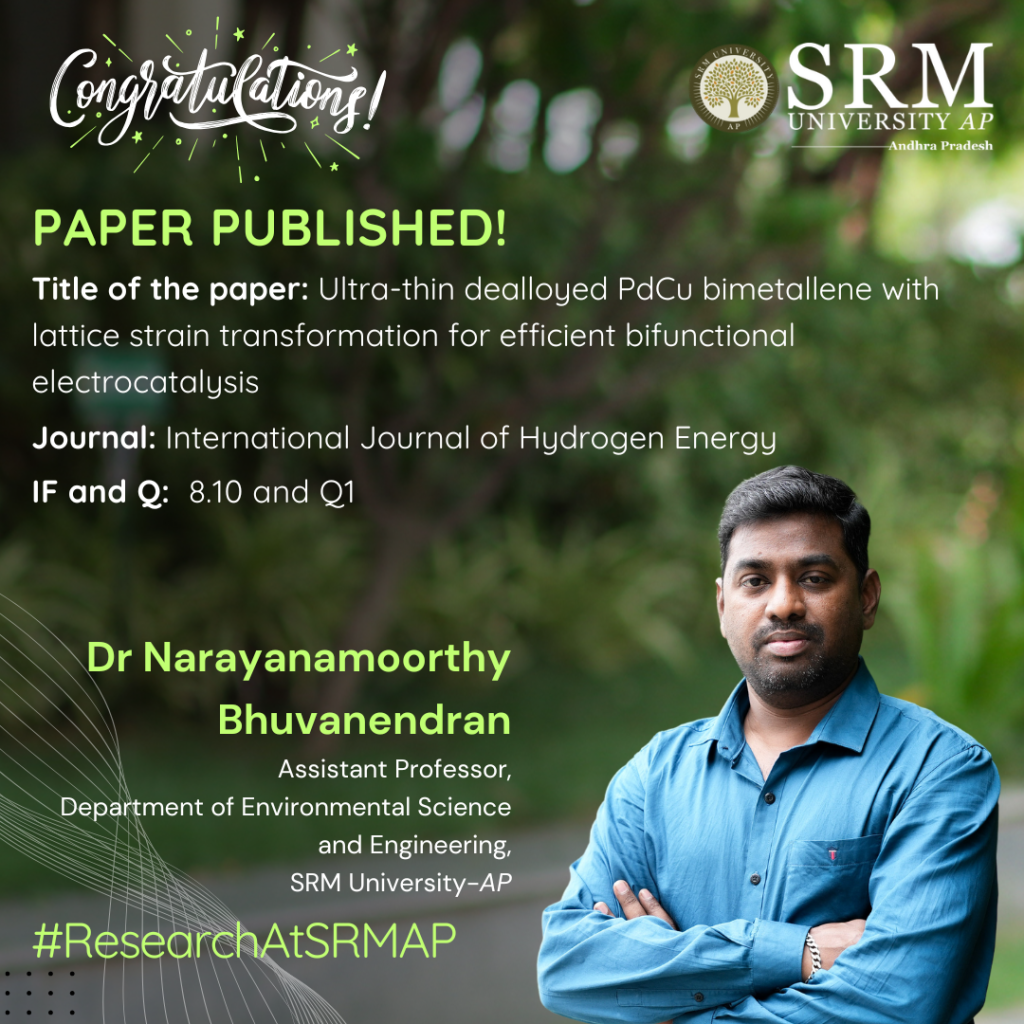
Dr Narayanamoorthy Bhuvanendran, Assistant Professor in the Department of Environmental Science and Engineering, has published his research work as an article titled “Ultra-thin Dealloyed PdCu Bimetallene with Lattice Strain Transformation for Efficient Bifunctional Electrocatalysis” in the esteemed International Journal of Hydrogen Energy, which has an impact factor of 8.10. His work underscores the development of 2D PdCu bimetallene with improved structural and electronic properties displaying super-catalytic behaviour.
Abstract
Two-dimensional (2D) PdCu bimetallene (PdCu) demonstrates exceptional structural and electronic properties, making it highly effective for electrochemical reactions in energy applications. Electrochemical dealloying (DA) of PdCu enhances surface reactivity by modulating electronic structure and inducing strain, optimising its performance for oxygen reduction (ORR) and methanol oxidation (MOR) in alkaline media. DA PdCu features a heterogeneous surface with abundant defects, improving active site availability and reaction kinetics. It achieves superior ORR mass activity (0.62 mA µg⁻¹) with a 10 mV positive half-wave potential shift after 20,000 cycles and MOR mass activity (3335.9 mA mg⁻¹) with 62.3% retention after 10,000 cycles. Theoretical studies reveal the impact of strain-induced electronic modulation on intermediate adsorption energies, corroborating experimental findings. This alloying-dealloying strategy in 2D PdCu bimetallene offers a robust approach to advancing multifunctional electrocatalysis with enhanced durability and performance.
Explanation of the Research in Layperson’s Terms
This research highlights the development of a two-dimensional PdCu bimetallene catalyst with tailored structural and electronic features, offering transformative advancements for electrochemical energy conversion and storage systems. The unique properties of 2D metallene layers, including their high surface area, tunable electronic structure, and enhanced surface reactivity, play a pivotal role in optimising catalytic performance. By employing a controlled dealloying process, the atomic and electronic structure of PdCu bimetallene is significantly modified, introducing lattice distortions, abundant surface defects, and a heterogeneous crystalline-amorphous interface. These features create more active sites and improve the interaction with reaction intermediates, leading to superior catalytic behaviour. The material demonstrates outstanding efficiency in oxygen reduction (ORR) and methanol oxidation (MOR), critical reactions in fuel cells and other electrochemical energy systems. For ORR, the catalyst achieves high mass activity, long-term stability, and resistance to degradation, maintaining its performance after extensive testing. In MOR, the catalyst exhibits exceptional activity and durability, retaining a significant portion of its efficiency over prolonged cycles. These structural and functional attributes emphasize the importance of 2D metallene designs and the alloying-dealloying strategy in enhancing the structure-activity relationship, establishing a foundation for innovative electrocatalysts in sustainable energy technologies.
Practical Implementation/ Social Implications of the Research
This research offers a practical pathway to revolutionise renewable energy systems by advancing next-generation electrocatalysts for fuel cells, metal-air batteries, and other energy conversion technologies. The optimised two-dimensional PdCu bimetallene, with enhanced ORR and MOR performance, demonstrates significant potential for clean energy applications such as proton-exchange membrane fuel cells and direct methanol fuel cells, addressing critical needs for efficiency and durability. The scalable, environmentally friendly alloying-dealloying synthesis reduces reliance on expensive platinum, lowering production costs while delivering high catalytic performance. By enabling efficient energy storage and conversion, supporting carbon-neutral systems, and inspiring the design of versatile 2D metallenes for diverse applications, this research significantly contributes to sustainable energy transitions and global climate goals.
Collaborations
- Prof. Sae Youn Lee, Department of Energy and Materials Engineering, Dongguk University, Seoul, Republic of Korea.
- Dr Wan-Gil Jung, Korea Basic Science Institute, Gwangju Center, Republic of Korea.
- Prof. Ming-Chang Lin, Department of Applied Chemistry, National Yang-Ming Chiao Tung University, Hsinchu, Taiwan.
- Dr Venkatesan Srinivasadesikan, Department of Chemistry, School of Science and Humanities, Vignan’s Foundation for Science, Technology and Research, Guntur, Andhra Pradesh, India.
Future Research Plan
Future research will focus on designing nanostructured hybrid electrocatalysts with enhanced activity, stability, and selectivity for energy and environmental applications. Emphasis will be placed on tailoring nanoscale architectures and synergistic material interactions to optimize performance in processes such as water splitting, CO2 reduction, NO3 reduction, fuel cells, and pollutant degradation, enabling scalable and sustainable solutions to global challenges.
Continue reading → - OCIT-2024: An International Conference Exploring Trends in Information Technology December 31, 2024

The 22nd OITS International Conference on Information Technology (OCIT-2024) was hosted at SRM University-AP from December 12 to 14, 2024. The conference, which served as a premier platform to discuss advancements in information technology, brought together distinguished academics, researchers, industry professionals, and students from across the globe. OCIT-2024 witnessed a submission of 600 research papers, out of which 136 papers were accepted and registered for presentation after rigorous review.
OCIT 2024 had seven keynote speakers who delivered insightful presentations, offering deep expertise and futuristic perspectives on emerging trends: Prof. Arun Kumar Pujari, HOD of AI & CSE, Adviser & Professor Emeritus Mahindra University, Prof. Banshidhar Majhi, Professor (HAG), Comp Sc.& Engg. NIT Rourkela, Former Director, IIITDM KP, Former VC, VSSUT Burla, Prof. Prabir Kumar Biswas, IIT Kharagpur, Prof. Sharad Sharma (University of North Texas UNT), Dr Kannan Srinathan (IIIT Hyderabad), Prof. Siba Kumar Udgata (University of Hyderabad), Dr Kumar Goutam (Founder & President of QRACE).
Esteemed session chairs guided thought-provoking discussions, elevating the intellectual rigour of the conference. Presenters also shared cutting-edge research, fostering a vibrant exchange of ideas and innovation. The topics explored ranged from artificial intelligence and machine learning to advanced networking and quantum computing. The conference emphasised the importance of collaboration between academia and industry in addressing global challenges and shaping the future.
The conference concluded on a high note, inspiring participants to continue their pursuit of excellence in research and innovation. 12 papers were recognised as the best papers for their exceptional quality and contribution. All 136 accepted papers will be published in IEEE Xplore (Scopus Indexed). Additionally, approximately 15% of the papers will receive extended invitations for submission to peer-reviewed journals.
OCIT-2024 was a remarkable event, leaving a lasting impact on its participants and setting the stage for future technological advancements. The event celebrated the spirit of innovation and research through well-curated presentations.
Continue reading → - Dr Gavaskar Publishes Patent on Generating Prompts December 26, 2024
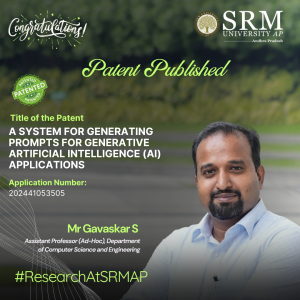
The Department of Computer Science and Engineering is proud to announce that Dr S Gavaskar has published his patent titled A System for Generating Prompts for Generative Artificial Intelligence (AI) Applications (Application Number: 202441091788). This groundbreaking invention will prove to be a significant advancement in the field of AI, enabling the creation of contextually rich and user-specific prompts, thereby enhancing the accuracy and usability of generative AI systems across various domains.
A Brief Abstract:
This research invention relates to Prompt creation process for Generative AI Application by introducing Four way corpus directory(FWCD) comprising the Persona corpus, Localized Application Specific Content Corpus, Annotator corpus, and Stopword corpus to create well-formed, contextual prompts for AI models. It also employs Semantic Based Categorization and Ranking(SBCR) for semantically categorizing and ranking the content present in the Localized Application Specific Content Corpus . The invention improves the interaction between users and Generative AI. It helps deliver more accurate, semantic based outputs from the AI models, improving the overall performance and usability of the system.
Explanation in Layperson’s Terms:
Prompt engineering is the process of using natural language to create instructions that generative artificial intelligence (AI) models can understand and interpret.In this research we have create a system for prompt creation by which the users can create their own prompt with the combination of their persona details,stopword,annotator content from their localized corpus directory before applying to the LLM models such as ChatGPT,Copilot etc.
Practical Implementation / Social Implications:
- This concept can be implemented in Education Institutions to generate tailored prompts for learning materials and academic projects.Enterprises can use localized content to generate role-specific prompts. and marketing organizations can use to create prompts aligned with specific campaigns or audience demographics.It can also be used in organizations where multiple persons with different roles and responsibilities are there and they have their own localized content for which a prompt has to be created for an Generative AI Application.
This invention also lets people from different skill levels access the system and create their own prompt for their applications.
Future Research Plans:
Future research focus is on creating LLM and AI related applications to the field related to education.cyber security,Legal and Enterprises.
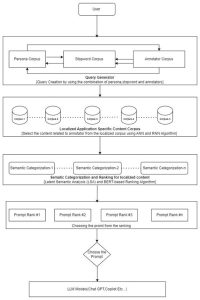
Continue reading → - This concept can be implemented in Education Institutions to generate tailored prompts for learning materials and academic projects.Enterprises can use localized content to generate role-specific prompts. and marketing organizations can use to create prompts aligned with specific campaigns or audience demographics.It can also be used in organizations where multiple persons with different roles and responsibilities are there and they have their own localized content for which a prompt has to be created for an Generative AI Application.
- Smart Solutions for Road Safety December 26, 2024
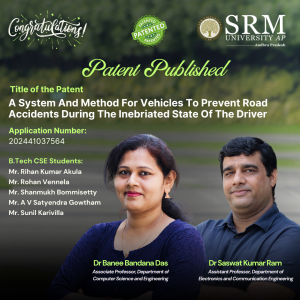 Dr Saswat Kumar Ram and Dr Banee Bandana Das from the Department of Electronics and Communication Engineering have developed an intelligent safety system to prevent road accidents caused by drowsiness and alcohol consumption. Their patented research, A System and Method for Vehicles to Prevent Road Accidents During the Inebriated State of the Driver (Indian Patent No. 202441037564), uses simple sensors and microcontrollers to provide real-time safety feedback, offering an affordable and effective solution for enhancing vehicle safety.
Dr Saswat Kumar Ram and Dr Banee Bandana Das from the Department of Electronics and Communication Engineering have developed an intelligent safety system to prevent road accidents caused by drowsiness and alcohol consumption. Their patented research, A System and Method for Vehicles to Prevent Road Accidents During the Inebriated State of the Driver (Indian Patent No. 202441037564), uses simple sensors and microcontrollers to provide real-time safety feedback, offering an affordable and effective solution for enhancing vehicle safety.A Brief Abstract:
This research offers the best solution to improve security measures in the control system by integrating simple sleep and odour sensors. The goal is to create an intelligent safety management system. The devices used are microcontroller, motor drivers, motors, MQ-3 (alcohol sensor), IR sensor (drowsiness detection), buzzer, and lights, these are the main components used in this project for hardware. The embedded-C language is used for the Arduino IDE. The system is designed to provide safety feedback in a variety of applications. MQ-3 can be used to detect and identify environmental odours in people, whether drunken. Our aim is to design product that can be inexpensive and easy to integrate into existing control systems, making it suitable for many applications such as automobiles, workplaces, and homes. This research is a good step towards improving the security of the control system by using the ability of simple and inexpensive equipment for instant monitoring and response.
Explanation in Layperson’s Terms:
The proposed safety control system effectively detects drowsiness and alcohol consumption, utilizing simple sensors MQ-3 and IR sensor to enhance road safety. By integrating these sensors with Microcontroller, the system triggers real-time alerts to prevent accidents. Upon detecting alcohol, the car automatically slows down, minimizing speed and activating LED backlights to indicate the driver’s inebriated state. Similarly, when drowsiness is detected, the system reduces car speed, emits a buzzing sound, and activates lights, signaling the driver’s drowsy condition. This comprehensive approach addresses both drowsiness and alcohol consumption, two major contributors to road accidents. The system’s simplicity, affordability, and ease of integration make it a promising solution for enhancing vehicle safety.
Practical Implementation
The current invention addresses the generic problems that cause road accidents and tries to control the speed of the vehicle and play buzzer to ensure the safety of the passengers and driver. To best of authors’ knowledge, th parameter detection i.e. alcohol and drowsiness detection.
The present invention can be used in smart city and smart villages applications for making the road safe, driver and passengers safe, and few application areas are:
- Smart City and Smart Village: This technique and system can reduce road accidents caused due to alcohol consumption and drowsiness.
- Automobile Industry: The system can be easily integrated with the existing control system in vehicles to ensure safety.
Future Research Plans:
To develop more secure and reliable safety mechanism for safe driving.
Continue reading → - Unveiling Microplastic Pollution in Landfill-Mined Bio-Earth December 26, 2024
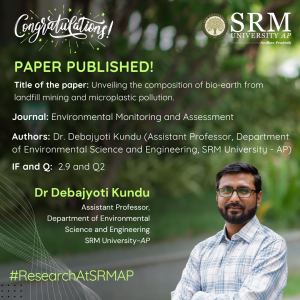 Dr Debajyoti Kundu, from the Department of Environmental Science and Engineering, has conducted pioneering research on the composition of bio-earth recovered from landfill mining at the Bhandewadi landfill in Nagpur, India. His study, Unveiling the Composition of Bio-Earth from Landfill Mining and Microplastic Pollution, reveals the presence of microplastics in bio-earth, raising concerns about its safety for agricultural use. The research underscores the importance of addressing microplastic contamination to ensure the sustainable application of landfill-mined materials in agriculture.
Dr Debajyoti Kundu, from the Department of Environmental Science and Engineering, has conducted pioneering research on the composition of bio-earth recovered from landfill mining at the Bhandewadi landfill in Nagpur, India. His study, Unveiling the Composition of Bio-Earth from Landfill Mining and Microplastic Pollution, reveals the presence of microplastics in bio-earth, raising concerns about its safety for agricultural use. The research underscores the importance of addressing microplastic contamination to ensure the sustainable application of landfill-mined materials in agriculture.A Brief Abstract:
This study explores the composition of bio-earth derived from landfill mining at the Bhandewadi landfill, Nagpur, India, and investigates the presence of microplastics within it. The bio-earth was characterized by key parameters such as moisture content, organic carbon, nutrient levels, and heavy metal concentrations. Microplastic contamination was also assessed using ATR-FTIR spectroscopy, revealing a significant presence of microplastics in the bio-earth. The findings highlight the need for further research and strategies to mitigate microplastic pollution to ensure the safe use of bio-earth in agricultural applications.
Explanation in layperson’s terms:
In this study, we looked at bio-earth, which is a material recovered from old landfill sites, and examined its quality and the presence of harmful microplastics. Landfill mining is an emerging technique that helps recover valuable resources from old waste. Bio-earth is often used as a natural fertilizer, but the problem is that it can contain tiny plastic particles (microplastics) which can harm the environment. Our research found that the bio-earth from a landfill in Nagpur, India, had both useful nutrients for plants and significant levels of microplastics. This is concerning because it could affect the safety of using such material in farming or gardening. Our work suggests that more research is needed to figure out how to remove these plastics and make the bio-earth safer for agricultural use.
Practical Implementation:
The findings of this research have significant implications for environmental management and waste recycling. The presence of microplastics in bio-earth poses risks to soil health, plant growth, and potentially to human health when used in agriculture. The research highlights the need for proper waste management techniques to reduce microplastic contamination and improve the safety of recycled materials like bio-earth. This study also calls for developing strategies to remove or reduce microplastics from landfill mining processes, ensuring that bio-earth can be used safely as a fertilizer or soil conditioner without further environmental harm.
Collaborations:
This research was conducted through collaboration between several esteemed institutions:
CSIR – National Environmental Engineering Research Institute (CSIR-NEERI), Nagpur, India
Banaras Hindu University (BHU), Varanasi, IndiaFuture Research Plans:
We plan to develop methods for removing microplastics from bio-earth, assess their impact on soil and plant health, and explore sustainable waste processing techniques to reduce plastic contamination. Our goal is to enhance the safety and sustainability of landfill-mined materials in agriculture.
The link to the article:
https://link.springer.com/article/10.1007/s10661-024-13229-2
Continue reading →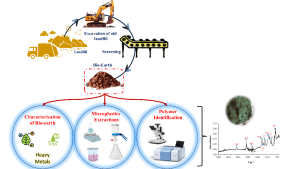
- Dr Kaushik’s Research on Hydrogen Peroxide Mediated Thermo-Catalytic Conversion of Carbon Dioxide December 26, 2024
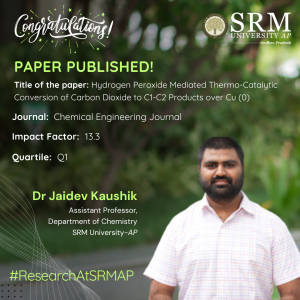 Dr Jaidev Kaushik, Assistant Professor from the Department of Chemistry, has introduced an innovative method for converting CO₂ emissions into valuable products like acetic acid, offering a sustainable solution to combat climate change. His groundbreaking research has been published in the Chemical Engineering Journal under the title, Hydrogen Peroxide Mediated Thermo-Catalytic Conversion of Carbon Dioxide to C1-C2 Products over Cu(0).
Dr Jaidev Kaushik, Assistant Professor from the Department of Chemistry, has introduced an innovative method for converting CO₂ emissions into valuable products like acetic acid, offering a sustainable solution to combat climate change. His groundbreaking research has been published in the Chemical Engineering Journal under the title, Hydrogen Peroxide Mediated Thermo-Catalytic Conversion of Carbon Dioxide to C1-C2 Products over Cu(0).A Brief Abstract:
The global challenge concerning CO2 conversion to valuable products is anticipated to play a critical role towards net zero carbon emissions. Thermal CO2 reduction is advantageous in terms of higher conversion rates, selectivity, and already-established industrial thermal instruments for scalability. However, the method is energy-intensive, a hindrance to sustainably practical adoption. Herein, we present a comprehensive study of H2O2-mediated thermal CO2 conversion in the presence of dendritic zerovalent copper (d-ZCu) in a batch-type reactor, yielding C1 and C2 carbon products, with acetic acid (AcOH) as the major product (achieving an optimized yield of approximately 0.98 M and a selectivity of around 97% at near-ambient conditions of 25-150°C and 1-15 bar), along with trace amounts of methanol and ethanol, and carbon monoxide (CO) as a gaseous product. The reaction parameters, including temperature, time, pressure, and concentrations, were optimized to gain better insight into the reaction. To further explore the feasibility of the process, experiments were conducted in a continuous flow-packed bed reactor using similar parameters as those in the batch reactor, where CO was identified as the primary product of CO2 reduction. For advanced real-life applicability, the as-emitted exhaust gases from diesel and petrol engines, as sources of anthropogenic CO2, were utilized to establish the practical applicability of the proposed method.
Explanation in Layperson’s Terms:
In our work, we found a way to convert CO2, a gas that contributes to climate change, into useful products. We used hydrogen peroxide and a special type of copper catalyst (zerovalent and dendritic shaped) to change CO2 into things like acetic acid (used in vinegar), methanol, ethanol, and carbon monoxide. The main product we made was acetic acid, and the process worked well at lower temperatures and pressures, which means it used less energy. To see if this could be useful in real life, we tested it with CO2 coming from car exhaust, including diesel and petrol engines, and found that it could help reduce pollution. This shows that our method could be a practical way to reduce CO2 emissions from everyday sources.
Practical Implementation and Social Implications:
The practical implementation of our research offers a promising solution for reducing CO2 emissions by converting this harmful gas into valuable products like acetic acid, methanol, ethanol, and carbon monoxide. We used hydrogen peroxide and a dendritic zerovalent copper to operate our method at lower temperatures and pressures, making it more energy-efficient than traditional CO₂ reduction techniques. The implementation of this approach may not only help industries reduce their carbon footprint but also provide economic value by synthesizing widely used products. A key social benefit is its potential to capture and convert CO2 emissions from everyday sources, such as car exhaust, demonstrating how this method can help reduce pollution in urban environments. Overall, this technology supports the global effort to achieve net-zero carbon emissions, offering a practical and scalable solution for industries and everyday applications alike.
Collaborations:
Dr Sumit Kumar Sonkar (MNIT Jaipur, India)
Future Research Plans:
- The adsorption/photodegradation-assisted quick and efficient removal of next generation advanced pollutants such as microplastic, pesticides, pharmaceutical waste, etc. by hydrophobic carbon aerogel and their doped and functionalized versions.
- Utilizing waste derived heterogeneous catalysts in organic transformation reactions.
- Selective sensing of toxic metal ions/biomarkers/biomolecules using fluorescent nanomaterials.
- Upcycling of carbonates/CO2 via photo/thermal assisted reactions to get C1 and C2 hydrocarbons (green fuel).
The link to the article
https://www.sciencedirect.com/science/article/abs/pii/S1385894724082779
Continue reading → - Dr Bidisha on Translating Dalit Voices December 25, 2024
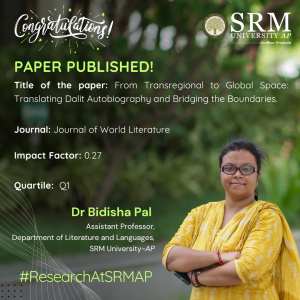 Translation often serves as a vital bridge between languages and cultures and Translators are often poised as “gatekeepers” who preserve the authenticity and richness of a text. Dr Bidisha Pal, Assistant Professor at the Department of Literature and Languages in her research paper, “From Transregional to Global Space: Translating Dalit Autobiography and Bridging the Boundaries” speaks of the power of translation in safeguarding and raising awareness of caste. Her work also illustrates how translation smoothens the divide between language and enables the voice of the marginalised to be heard.
Translation often serves as a vital bridge between languages and cultures and Translators are often poised as “gatekeepers” who preserve the authenticity and richness of a text. Dr Bidisha Pal, Assistant Professor at the Department of Literature and Languages in her research paper, “From Transregional to Global Space: Translating Dalit Autobiography and Bridging the Boundaries” speaks of the power of translation in safeguarding and raising awareness of caste. Her work also illustrates how translation smoothens the divide between language and enables the voice of the marginalised to be heard.Abstract:
The present research brings forward some standpoints. First, the translation of Dalit autobiographies creates transnational solidarity. Second, the translators play the role of gatekeepers to show that translation sustains the literary and cultural essence ingrained within the texts and initiates and engages dialogic discussions among the audience and readers on the global platform. Third, the translation of Dalit autobiographies arrests the attention of those global readers who barely nurture any idea on caste, class, and casteist politics and deep-rooted issues like untouchability in India and constructs a distinct literary geography.
Explanation in layperson’s terms:
The research deals with the idea of literary translation and its necessity. These two autobiographies are written in regional Bengal. When translated, the boundary of regions gets dissolved, and the essence of the texts reach the global arena. Besides, translation also acts as the bridge to the outer world. However, oftentimes the act of translation is not an innocent act anymore; rather it interferes with the original meaning to transcreate.
Practical/ Social Implications:
The research talks about translation and its necessity to bridge boundaries. The texts that the article focuses on are from the people of the marginalized communities of Bengal who write to voice their concerns and who feature in a considerable period of history that should be known to people. Since, linguistic regionalism is the main constraint for the literary texts, translation provides the desired space and opportunity to help them reach the global platforms and their history and literature become part of the larger repertoire of World Literature.
The link to the article:
Journal of World Literature Volume 9 Issue 4 (2024)
Continue reading → - Where Technology Meets Literature: Reviving Sindhi Libraries with a Digitised Five-point Framework December 24, 2024
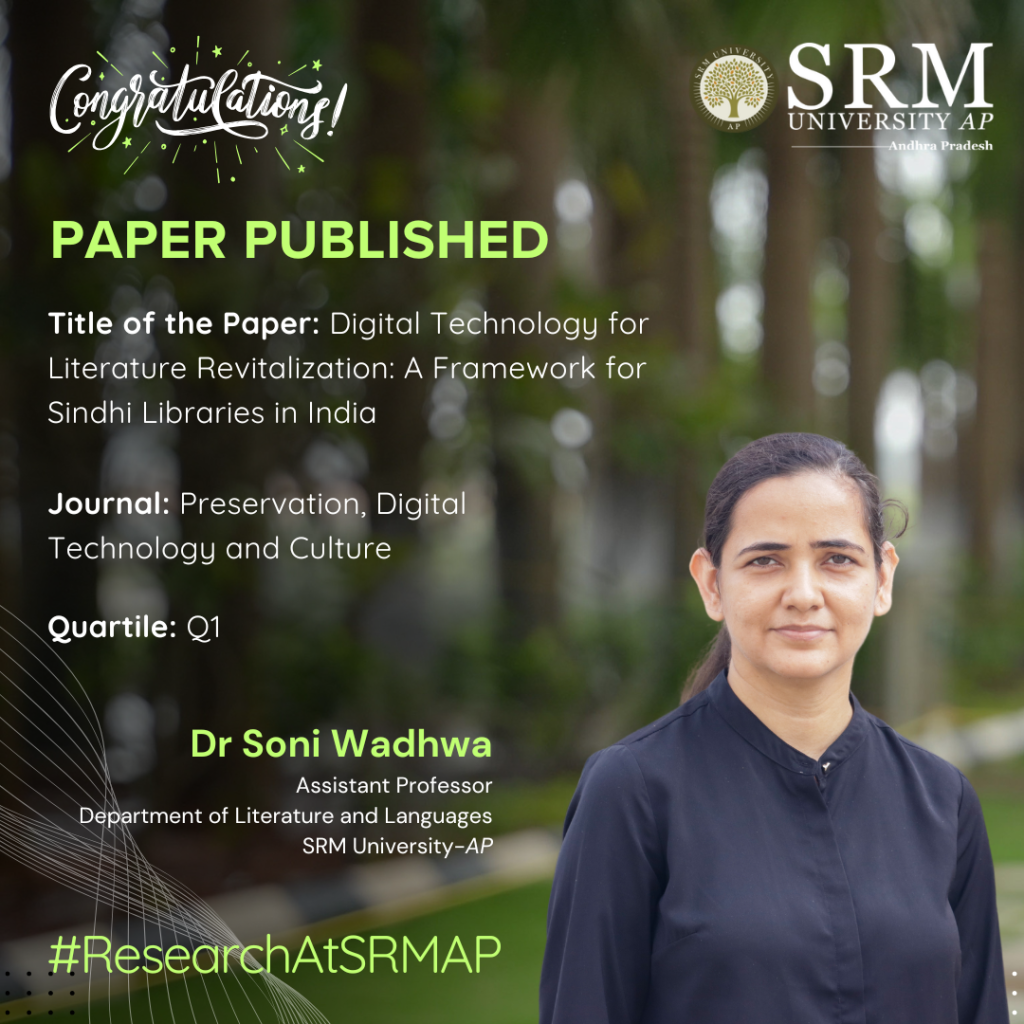
Minor languages face many challenges in India and elsewhere. With most of these languages on the verge of extinction, preservation efforts using technology need to develop a different vision for helping these languages and their communities. Dr Soni Wadhwa, Assistant Professor from the Department of Literature and Languages, has published her research in the article “Digital Technology for Literature Revitalisation: A Framework for Sindhi Libraries in India” in the Q1 journal Preservation, Digital Technology and Culture, highlighting on overcoming these challenges. Her research emphasises a five-point framework to revive Sindhi literature.
Abstract
Linguistic diversity does not find adequate space in LIS discourses around libraries in India and other regions with similar kinds of linguistic heritage. This study focuses on the state of Sindhi literature in India through a look at the libraries that house the works of Sindhi literary activity in post-Partition India. The objective is to highlight the role of libraries within language revitalization efforts. This study puts forth a five-point framework for digital transformation of Sindhi libraries in India which can help broaden the digital transformation efforts elsewhere in the Global South especially with minor languages and dialects. While the five-point framework is customized to the specific challenges faced by Sindhi regarding its script (and includes designing solutions for OCR, transliteration, and text to speech interaction), its principles could be applied to several other linguistic contexts, especially in the Global South. It, thus, seeks to bring LIS into sharp focus within the social imagination of communities of readers and as speakers of a language, and not just as academic institutions alone.
Practical Implementation/Social Implications of the Research
- Using this five-point framework, scholars from various fields (history, partition studies, language, literature, digital humanities, digital archiving, etc) can identify different ways of preserving the Sindhi language.
- The use of technology for this purpose can lead to technological innovation, which in turn can accelerate preservation efforts.
- Similar models and frameworks can be developed for other minor languages.
Collaboration
The project is funded by IIT Indore.
Continue reading →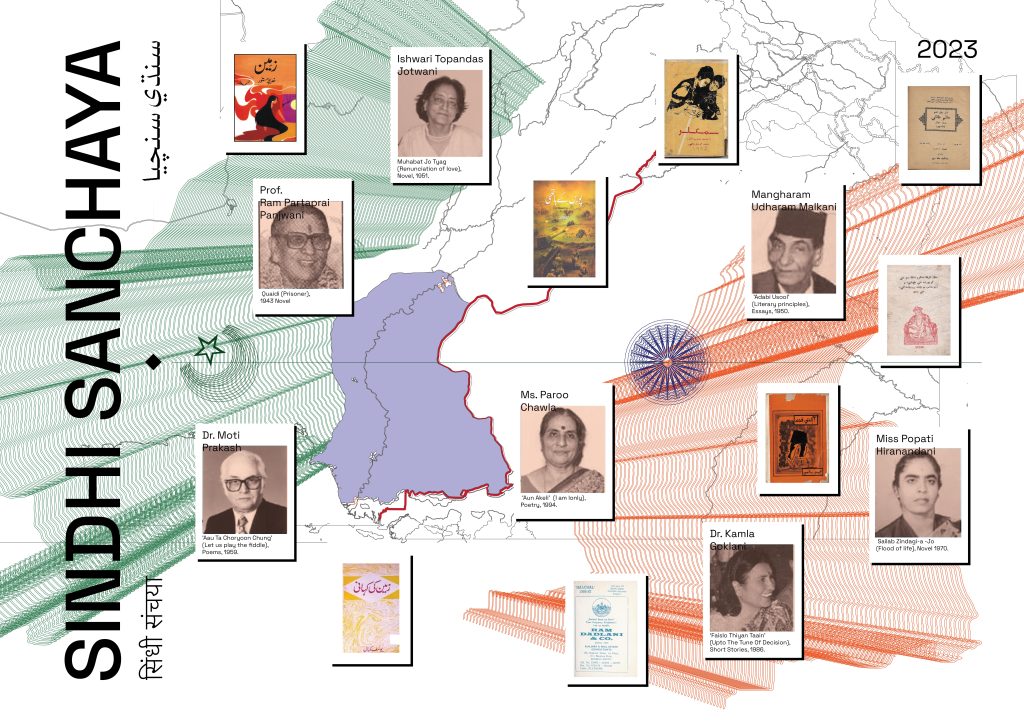
- A Unified Learning Framework for Detecting Cyberattacks in IoT Networks December 23, 2024
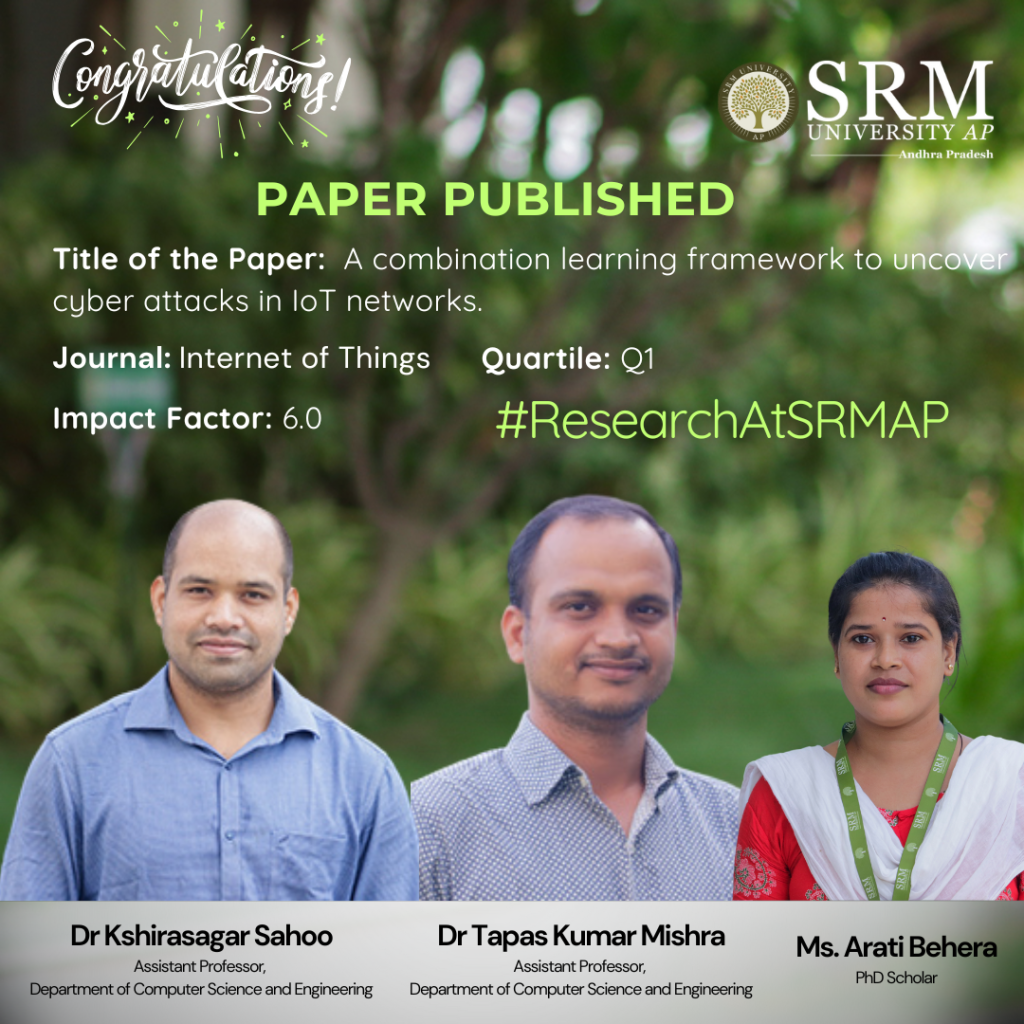
The Department of Computer Science and Engineering is proud to announce that Assistant Professors Dr Kshira Sagar Sahoo and Dr Tapas Kumar Mishra, along with their research scholar Ms Arati Behera, have published their paper “A Combination Learning Framework to Uncover Cyberattacks in IoT Networks” in the prestigious Q1 journal Internet of Things, which has an Impact factor of 6.
The article addresses IoT security challenges by utilising Software Defined Networking technology and AI. The authors use Genetic Algorithm to select the most important data features and a hybrid deep learning model combining CNN, Bi-GRU, and Bi-LSTM to detect cyber-attacks effectively. Tested on real-world IoT datasets, the system demonstrates superior accuracy, faster detection, and lower resource usage than existing methods, making it a promising solution for securing resource-constrained IoT networks.
Abstract
This study addresses the security challenges in IoT networks, focusing on resource constraints and vulnerabilities to cyber-attacks. Utilising Software Defined Networking and its adaptability, the authors propose an efficient security framework using a Genetic Algorithm for feature selection and Mutual Information (MI) for feature ranking. A hybrid Deep Neural Network (DNN) combining CNN, Bi-GRU, and Bi-LSTM is developed to detect attacks. Evaluated on InSDN, UNSW-NB15, and CICIoT 2023 datasets, the model outperforms existing methods in accuracy, detection time, MCC, and resource efficiency, demonstrating its potential as a scalable and effective solution for IoT network security.
Practical Implementation/ Social Implications of the Research
The practical implementation of this research lies in enhancing the security of IoT networks, which are increasingly integral to smart homes, healthcare, transportation, and industrial systems. By detecting and mitigating cyber-attacks efficiently, the proposed model can safeguard sensitive data, prevent service disruptions, and ensure the reliability of IoT systems.
Collaborations
This research has been conducted in partnership with Umea University Sweden.
Future Research Plans
There is potential to enhance the Deep Learning approach further to reduce the execution time at the power crunch device. Additionally, federated learning could be investigated as a use case, especially concerning edge devices within typical software-defined IoT networks.
Continue reading → - Developing a High Gain Bi-directional Converter to Improve Efficacy in EV Applications December 23, 2024

Electronic Vehicles (EVs) are a key element of carbon emission reduction strategies and pivotal to contributing to sustainable development. Operating solely on electrical energy, eliminating the need for petrol or diesel, EVs leave a significantly reduced carbon footprint compared to fossil fuel-powered vehicles. Underscoring the impact of EVs on the environment, advanced research is conducted to improve the efficacy and reliability of EVs.
On this note, a research team from the Department of Electrical and Electronics Engineering – Dr Tarkeshwar Mahto, Dr Somesh Vinayak Tewari, Dr Ramanjaneya Reddy and PhD scholar Ms K Mounika Nagabushanam has published a paper titled “High Gain Bi-directional KY converter for low power EV Applications” in the Q1 journal Energy having an Impact Factor of 9. Their research work focuses on the development of a bi-directional DC-DC converter that can be used in EVs for integration of battery to traction motor.
Abstract
In electric vehicles (EVs), the type of electric motor and converter technology have a significant impact on regulating the operational characteristics of the vehicle. Therefore, in this work, the modified bi-directional KY converter (BKYC) is proposed for EV applications. The main contributions of the proposed converter are high step-up/step-down conversion gain, bi-directional power flow, simplified control structure, continuous current, common ground, low volume, and high efficiency. An inductor on either side of the converter ensures continuous current flow and passive components are arranged to operate in series to offer high step-up/step-down conversion. The charging and discharging operations, steady-state analysis, and design process of the proposed converter are discussed in detail and compared with similar bi-directional converter topologies. Further, the efficiency analysis of the proposed converter is presented, and it was found that the efficacy is 95.51% in the charging operation and 96.52% in the discharging operation. The simulations are carried out using MATLAB/Simulink environment. Further, a prototype of a modified bi-directional KY converter is implemented with a TMS320F28335 processor and validated with theoretical and simulation counterparts.
Explanation of the Research in Layperson’s Terms
Electric vehicles (EVs) are built with traction motors, charging circuits, energy storage devices, and lighting systems. Each runs at a different voltage and has a different power level. Various power electronic converters are used to integrate the individual components of an electric vehicle. An electric vehicle (EV) runs primarily on battery power, which can be obtained from on-board charging or charging stations. The battery has a voltage range of 24 to 48 volts. The traction motor, coupled to a DC link bus with a voltage range of 400V to 600V, needs to receive this energy. Consequently, it is necessary to integrate a power converter to raise the voltage from lower voltage batteries to a higher voltage DC link. Additionally, energy lost during motor running can be used to charge batteries to improve the efficiency of the electric vehicle. Therefore, a separate power electronic converter is required for the power flow from the motor to the battery. The primary output of our study is the development of a bi-directional DC-DC converter that facilitates power flow from the battery to the motor and motor to the battery with the necessary voltage gains while maintaining improved efficiency and low cost.
The main challenges in EV technology are battery deterioration due to frequent charging and discharging and the volume of the power converter. The research team plans –
- To work on the noise reduction methods that are brought on by regeneration action
- To work on various control techniques to keep the DC link voltage of the propulsion system constant


